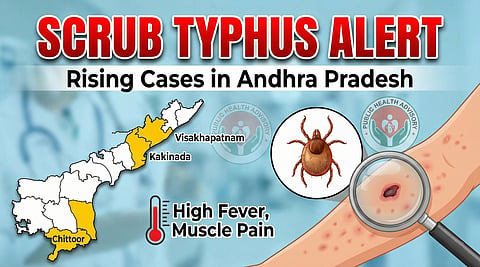

Andhra Pradesh is seeing a sharp uptick in scrub typhus cases, and health officials are sounding the alarm. Chittoor alone has reported about 400 cases, with Kakinada at 150 and Visakhapatnam at 125. These numbers have public health teams urging people to stay alert and take steps to protect themselves.
What is Scrub Typhus?
Scrub typhus isn’t just another fever. It’s a serious, often misunderstood disease, and without the right treatment, it can get dangerous—fast. People need to know how it spreads and, more importantly, how to avoid it.
Scrub typhus is an acute infection caused by the bacterium Orientia tsutsugamushi. Classic symptoms start with fever, headache, muscle pain, and sometimes a rash. About half of patients develop an eschar—a dark, crusty sore that looks a bit like a cigarette burn—where the mite bit them. That mark, though not always easy to spot, can be a big clue.
How Does It Spread?
You won’t catch scrub typhus from someone else. Instead, tiny infected chiggers—larval mites—pass it on when they bite. These mites love damp, overgrown places: thick bushes, tall grass, the edges of fields, especially after rain. Rats and other rodents carry these mites, often bringing them closer to homes.
Major Symptoms to Watch…
Symptoms usually kick in 6 to 21 days after a bite. The main signs: Sudden high fever (often above 102°F or 39°C), Bad headache, Chills, Aching muscles, Rash a few days after the fever begins, Swollen lymph nodes
If you develop these symptoms after spending time outdoors—especially in grassy or bushy areas—don’t wait. See a doctor right away. Early diagnosis and antibiotics make all the difference, and can prevent serious problems like pneumonia, heart inflammation, or trouble with the nervous system.
Precautions and Prevention
How do you stay safe? It mostly comes down to keeping those mites off your skin. Here’s what helps, especially if you live in or near the affected districts:
- Stay out of dense brush, tall grass, and overgrown fields when you can.
- Wear long sleeves and pants, and tuck your trousers into socks or boots. Closed shoes beat sandals every time in these conditions.
- Use insect repellents that have DEET or Picaridin on exposed skin. You can also treat clothes and gear with permethrin for extra protection.
- Keep your back-yard, farm-house or home clear of weeds, tall grass, and wild bushes. Less cover for mites means less risk.
- Control rodents around your home—they bring the mites closer.
- After outdoor activities, shower and scrub thoroughly. Wash your clothes in hot water with detergent. And finally, pay attention to your body. If you or your family start feeling sick after being outdoors, don’t ignore it. Early treatment saves lives. The rising numbers in Andhra Pradesh show this isn’t just a distant threat. With a little awareness and some simple precautions, people can protect themselves and help stop the spread of scrub typhus.
